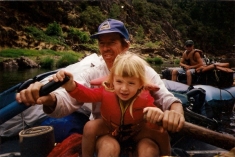Rebecca Dennis - The Stanislaus River
Originally published on Nobody's River Blog
River Roots
Every summer of my childhood started with the same celebratory ritual. We would load up in our big blue van with a rickety Datsun truck bed trailer in tow. The four of us kids and a lucky friend or two squeezed in tight behind my folks, squabbling for the window seat and giggling with anticipation for the cold water and long journey ahead.
I grew up in the Sierra Nevada foothills, a love child of the river. My parents met in the early 70s on the Stanislaus River while my 20-year-old mother Jacqueline was going to school and living in a canvas tent by the river and my father Fred was working with Mark Dubois and Ron Coldwell offering free trips down the river for inner city kids. This project later became a non-profit organization called Environmental Traveling Companions that still runs river trips for people with disabilities.
As the story goes, Dad asked Mom out on a moonlight run down the river and she never looked back. They spent the next five years living and working on the Stanislaus River – a time they describe with a twinkle in their eyes and a deep sense of love for one another and the river that brought them together.
They were part of an active conservationist group from the start. Their desire to protect the Stanislaus was born from a deep connection with a river that provided clean drinking water, a vibrant community, a sustainable economy and more. When the risk of a hydroelectric project on the Stanislaus became known, many people banded together within their community. They wrote letters, started petitions, and raised their voices at townhall meetings. One friend even chained himself to a rock in support of a free-flowing Stanislaus. Despite an incredible grassroots effort to protect this special place, the dam construction began in 1978 just five miles downstream of where my parents were living.
When I summon up memories of our summer pilgrimages I feel so much joy. I will never forget sitting on my dad’s lap and rowing as a little girl, rolling a kayak for the first time, or feeling so small as the river’s powerful eddy lines pulled at my little body. But there was also deep sadness as we headed home. The last piece of our ritual journey was the moment when we rolled across the Parrotts Ferry Bridge. My parents would crane their heads to the right and peer down into the deep dark reservoir. Silence would overcome us and I would see my parents looking at the place they would never be able to share with their children.
The Stanislaus was a special place for so many people and thousands fought to keep it from being destroyed. The New Melones Dam filled in that beautiful river canyon. It was one of the last big dams built in the US to conclude a 60-year dam-building frenzy. Even though I was not around to witness this loss, I feel — and have inherited — my parents’ grief for a place that was so dear to their hearts.
The old blue van no longer runs and all of my siblings are grown. But when the spring flowers bloom and the water starts running I still make that same pilgrimage. Without fail the water draws me in, and I go to the river to nourish my soul. On a river I am home – drifting downstream, listening to the roar of a rapid, connecting with people I love, or watching the light fade in the late evening. When I connect to places that make me feel small, I understand just how much we need them. Rivers are the lifeblood of our communities, the environment, and all living things. We all need wild rivers. And our children need them even more.
Rebecca Dennis is a member of Nobody’s River, a source to sea expedition across southern Siberia on one of the world’s greatest and least known free flowing rivers, the Amur. The four-person team of adventurers, explorers and biologists will travel from the far reaches of the Onon headwaters in Northern Mongolia to the Pacific Ocean delta. Starting in May and over the course of 3 months, the team will employ trains, horses, kayaks, rafts, and ferries to make their way to the sea. During the expedition the team will be collecting data, filming, photographing, and sharing this widely unknown place through media and storytelling.



